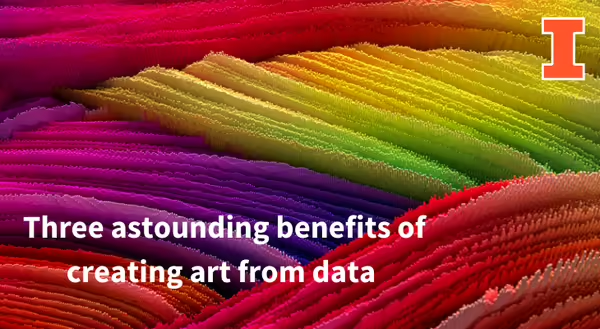
I have a confession to make. I am a data nerd. I love a good spreadsheet, seeing all those numbers (data points) neatly arrayed. But I am also an artist. And at first glance those two would seem to be incompatible. But they are not.
Data can be the inspiration for art. Don’t think so? Hear me out. Picture bar graphs, pie charts and infographics. (Who doesn’t love a good pie chart?) All of these are visual ways to convey data, often making it easier for the reader to comprehend the information and to discern patterns. Maybe, not quite art, but why stop there? And it turns out, there are good scientific reasons not to.
Three benefits of creating art from data.
- Improves mental health: engaging in the creative process relieves stress and provides a sense of accomplishment.
- Learn about place: Researching and keeping track of data in your area helps connect you to the place where you live.
- You focus deeply: making art induces what the scientific community calls "flow" — the sense of losing yourself, losing all awareness. You're so in the moment and fully present that you forget all sense of time and space
Reap the rewards for thinking outside the box and combine data and art. To encourage you, here are two artists using data in unique ways:
- Nathalie Miebach: She creates intricate sculptures of wicker and colored beads to depict massive storms and climate events. These sculptures accurately represent weather conditions such as temperature, wind speed and water patterns.
- Chris Jordan: In his book of digital photos, Running the Numbers, he takes dry, hard to comprehend statistics, like 100,000,000 trees are cut down each year and turns them into art. Picture a landscape of toothpicks, each representing a felled tree, stretching into the horizon.
Not artistic you say? You don’t need to be. Try cutting some pieces of construction paper into shapes, each color or shape representing a temperature and make a record of the daily high or low temperatures. Make a collage of the birds you see at your feeder by cutting out photos of the birds and gluing them to a piece of cardstock. Take a photo each day at the same time from the same spot and then arrange them into a larger work of art. The possibilities are endless. The only limitation is your imagination.
And since it’s the process of creation that provides the benefits, not the quality of the results there is no reason why you shouldn’t give it a try. So, what are you creating?
Quick Note: This is a great project to do with your kids. Kids are learning skills like data collection and creative thinking all while having fun and spending quality time with you. Sounds like a win-win.
Wendy Ferguson coordinates the Master Gardener and Master Naturalist programs in Henderson, Knox, McDonough and Warren Counties. Wendy earned a BS in Environmental Studies from Eureka College and a MS in Environmental Studies with an emphasis on writing and communication from Green Mountain College. She is interested in facilitating a deeper connection to place for community members through nature journaling and education. She is also an author for the Naturalist News blog.
Naturalist Notebook is a regional blog by University of Illinois Extension Master Naturalist staff and volunteers who bring you stories highlighting their experiences and practices which connects them to their community and place. Join us each month to gain new insights, be inspired and become connected to your own community by practicing their simple but insightful activities to deepen your own connections to the more than human world.